Modeling Sustainable Animal Husbandry
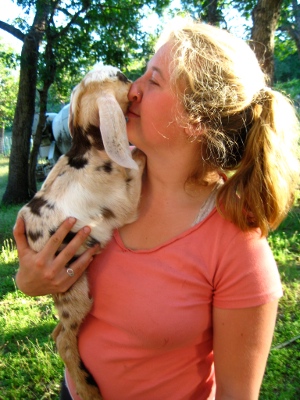
Since we are operating from a whole-system perspective of creating a rural village, there are many angles to view the complex and interconnected ways animals fit into life at Windward.
In basic terms, animals provide us with essential goods such as food, clothing, and raw materials for tools and craft, while also doing important work like controlling weeds and pests, generating topsoil, and preparing land for cultivation.
Our Husbandry Objectives
We approach animal husbandry with a many objectives, including:
- Allowing the animals to express their innate character and serve community by doing necessary work and leading fulfilling lives;
- Balancing the environmental impacts of animals with the specific needs of our native ecology in a safe and sustainable manner;
- Restoring and enhancing landscapes by generating and preserving soil fertility and developing appropriate manure management practices;
- Closing nutrient cycles by both producing animal feed from on-site materials, and reincorporating manure, blood-meal and bone-meal into the soil;
- Understanding how management practices and nutrition can improve the health and happiness of the animals;
- Utilizing the various products of animals in order to meet the core needs of a small rural village; and
- Deriving a diverse and sustainable yield from each species and individual animal while accomplishing all of the above objectives.
The integration and application of all of these goals entails patience, observation, consistency, creativity, empathy, and humility.
Taking examples from the past and present
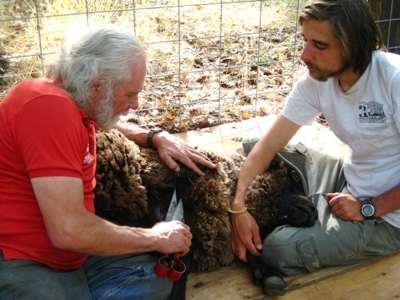
The annual ritual of shearing the sheep
In working toward these goals we draw inspiration and guidance from a range of examples through time:
From Spainish Dehesas, to Polyface Farm’s living example;
From Victorian era farming methods to, to modern poultry producers’ captive breeding of BSF larva for animal feed protein;
From Mongolian shepherdry, to the advice of our neighbors down to road.
Our model of sustainable animal husbandry strives to incorporate a wealth of human knowledge, both ancient and modern. Whatever works, use it!
While we study the examples of other people, we ultimately seek solutions that are appropriate in the particular conditions of our land. This quest involves more than just feeding animals. Our research and exploration delves into some of the deepest realms of sustainability.
In a future with dramatically less energy in the form of fossil fuels, we look for ways that animals can work in concert with the rest of our life-support systems to convert basic ingredients which are of marginal utility to humans—such as grass, acorns and insects—into highly valuable things like:
- Wholesome foods such as eggs and milk
- Raw materials for necessary products such as wool, leather, feathers and tallow.
- Essential Services such as retrient recycling, fertilization, rooting/tilling soil and minimizing unwanted plants and insects.
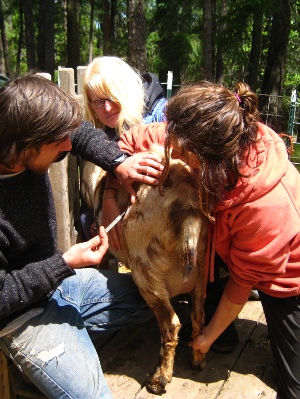
Giving Goats a BoSE shot after birthing
Working with animals
As stewards, animals are also our wards and companions, and we work daily doing a wide range of tasks like feeding, watering, milking and collecting eggs. Or processing the milk from the goats into cheese, yogurt and kefir. We also have regularly occurring as well as seasonal tasks like mucking out stalls, trimming hooves, and shearing the sheep.
As caretakers we also must address the health and physical well being of the animals. Some common health-care related work involves responding to health emergencies like a troubled labor; treating illnesses such as enteritis or conjunctivitis; and performing routine check-ups and procedures such as trimming hooves or nails.
In our experience, prevention is the best treatment of most illness and disorders and we endeavor to put in the work ahead of time to give our animals a good platform of health to build from.
A major component of health lies in good breeding. By allowing only the strongest and most well adapted animals to breed, while culling the others from the breeding population, we have been able over the years to produce some strong and resilient animals. However, there is always the reality of parasites and illness brought on by environmental conditions like cold moist winters. Learning how to take care of animals in as natural and holistic way as possible poses an intricate challenge that informs our approach to animal husbandry.
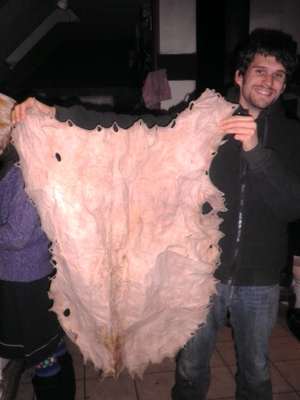
Ruben Holding up a brain tanned buckskin
One non-intuitive component of husbandry entails designing, constructing, maintaining and improving the physical infrastructure, buildings and habitat in which the animals live and depend on. This work involves building shelters, laying out fencing, cultivating land for growing animal feed, and much more.
A peripheral component of animal husbandry is learning the traditional skills and crafts associated with turning the materials animals supply into valuable end-products.
Windward has a wide array of tools for these tasks such as working with wool, tanning leather and pelts, making candles and soap, and more. There is something very right about being involved in the entire process, from raising and caring for animals, to killing and processing their bodies, and making the things you need from it. At Windward, you can participate in the whole circle.
In all of this work lies an opportunity to connect with nature on a deep level. Imagine wearing a sweater from a sheep you helped shear, clothing made of the materials provided by an animal you raised and cared for, or laying your head down on a pillow stuffed with duck feathers and you may recognize the important role animals can play in our lives to help us become fully human.
The Animals We Live With
In natural biological systems, diverse animal populations work together with plants, bacteria and fungi to perform essential life-supporting functions. As Windward takes nature as a premier model of sustainability, we are weaving together a variety of domesticated livestock, wildlife and support animals to meet the demands of building a sustainable village.
At Windward you will have the opportunity to experience and learn first hand the subtle reasons why we have chosen specific types of animals, and how they all fit into the fabric of sustainability that we are building.
Below are some descriptions of our various animal species we have on-site, and some of the things they do for us.

Chickens
Chickens are potentially the most quintessential homestead animal. Windward is keeping the tradition chicken rearing alive by developing a land-race breed that thrives in the particulars of our environment.
Layer chickens are a good examples of how animals help us turn things we’d prefer not to eat (in this case grass and bugs) into things we would like to eat (eggs, a tasty source of protein fat and other nutrients)
Learn more about Chickens at Windward
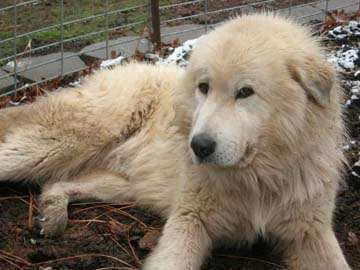
Dogs
Over the years, Windward has had many canine friends who have served a variety of purposes. From guarding our animals in the night, to helping to herd the sheep.
Currently we do not have any dogs on-site, but they have none the less played an important role in what we have done in the past. In the future we will look to incorporate dogs into our life again. Particularly guard dogs who can live with the animals and can keep watch for coyotes, skunks, and bobcats when we lay our heads down to sleep.
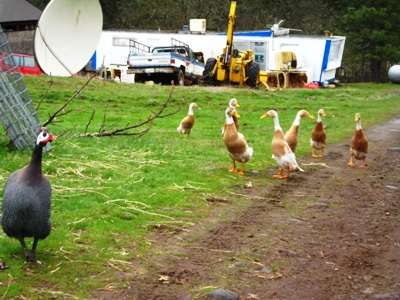
Ducks
Windward has two breeds of ducks, which serve a several different purposes. Indian Runner ducks are lean, small ducks that produce a relatively large quantity of eggs (upwards of 160 eggs a year per hen). Muscovy ducks are a larger meat breed of ducks that have proven to be able to incubate their own eggs and produce viable young.
Both of these breeds are also easy to manage and are excellent foragers. We let them free range most of the year because their webbed feet prevent them from tearing up plants like chickens do. Their aggressive bug hunting is one component of our approach to integrated pest management.
The ducks also have access to a pond which is a part of our liquid fertilizer system which feeds duck-ponics (a duck based aquaponics system) the overflow of which is send to a “green tank” that is used to water our main garden and orchard area.
Learn more about Ducks at Windward
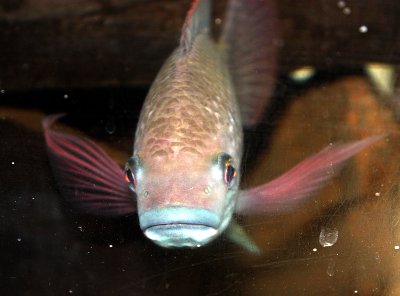
Fish
One of Windward’s cutting edge approaches to animal husbandry is in the area of aquaponics wherein fish are raised in a system where their liquid manure can fertilize plants. We have chosen Tilapia, more specifcally a breed of Nile Tilapia as our breed for experimenting with for a few reasons. First, because N.Tilapia are require less maintenance than other kinds of fish, and can thrive in higher nitrate conditions which are which means we need a less sophisticated filtration system.
This makes Tilapia particularly well suited to our model of low-overhead aquaponics facilities for rural communities. Tilapia in general are pretty efficient converters of feed into meat an N.Tilapia in particular because they are omniverous will forage on the algae and other plants that grow in their tank. This means in an optimal system, a pound of feed can produce more than a pound of fish. Wow!
Windward is currently working with some small to medium scale aquaponics systems which utilize carp and ducks as the source of fertilization; while also learning how best to care for Tilapia in an external, more straightforward fish tank setup. This process of developing a solid foundation in the basics before proceeding into a mature full-scale system is a good example of the way we work. There is a saying we tend to live by, take small bites, chew really well, and you probably won’t choke.
Learn more about Tilapia at Windward

Goats
It’s almost impossible to over-stress the importance of the role that goats play in the operation of a sustainable community on marginal land.
For thousands of years, folks living close to the land have used goats to produce the nutrient rich food that helped them raise healthy children, children who in turn grew up to be good at caring for goats. Do that for hundreds of generations, and you reach the point where humans and goats become a sort of co-evolved species.
If that sounds strange, well you’ll just have to come and get to know them. The first time you hear one of the yell for assistance, you’ll realize where humans got the word “help” from.
Windward is currently working with Anglo-Nubian dairy goats, and are underway in crossing Boer and Kiko meat breed lines with the Nubians to see if we can develop a sturdier milking goat while maintaining the high production of the Nubians.
Learn more about goats at Windward
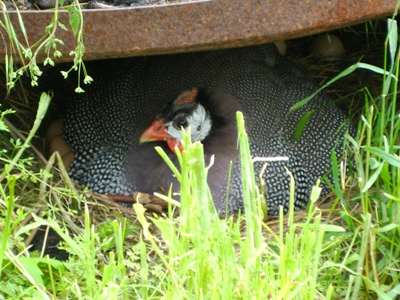
Guineas
Windward has had a roving flock of Guinea fowl for many years. Their primary task is to eat ticks and wasps in the areas where we live, so they do not become a nuisance. Besides our minimal feeding, the Guineas have more or less naturalized on our hillside. They eat pick through the remains of the goat pens, and forage in the pastures alongside the sheep. Their distinct calls are a part of the unique soundscpae of Windward.
Learn more about guineas at Windward
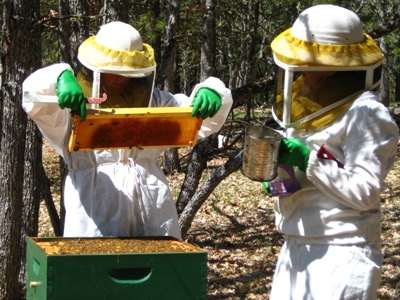
Insects
Insects are seldom thought of as “domesticated animals” but here at Windward we recognize insects’ irreplaceable contribution to meeting our core needs; both closing nutrient cycles by speeding the process of decomposition while creating animal feed and soil amendments in the process; and by pollinating our many flowering plants while creating valuable materials such as wax and honey. We are working with a few kinds of domesticated insects in our path to sustainability: Honeybees, black soldier flies, earth worms, meal worms, and dermestid beetles.
Each of these insects provide specific benefits and warrant an in-depth description of their own. Leave it to say that without these understated creatures we would not be able to do what we do.
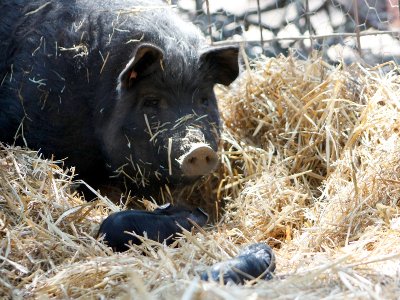
Pigs
In 2011 we added a breeding pair of pigs to our permanent crew of animals. We chose a small homestead breed called Guinea Hogs for a few reasons. Guinea hogs are smaller and more docile than other breeds making them safer and easier to handle. Being a homestead breed, they were bred to thrive in a foraging condition, eating acorns, grass, insects and roots.
We have been putting the pigs to use in various temporary enclosures to turn over soil and disturb the seed bed of unwanted or invasive species in preparation for seeding. We also anticipate the pigs to be a premier way for us to harvest the forests bounty of oil and protein that falls from the oaks in the form of acorns, into more readily consumable lard and pork.
Learn more about pigs at Windward
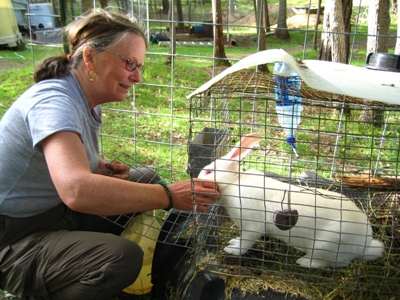
Rabbits
Rabbits play several roles here at Windward. The rabbit kids are awfully adorable so, over the past several years, we have been taking the baby rabbits into town for young kids to play with and have their picture taken. This is one special kind of “working animal”.
Our mix of Californian and New Zealand Rabbits are highly productive animals since they breed quickly, grow quickly, and make good gains from high fiber forage. If one needed to produce a lot of protein quickly, rabbits would be a good way to go.
Rabbit pelts are also a choice material for making the soft inner lining of cold-weather clothes that will come in close contact with the skin like gloves and hats. And their leather, once the hair has been removed, is exceptionally thin and flexible.
Learn more about rabbits at Windward
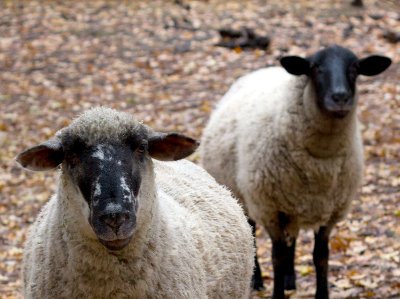
Sheep
There’s an old adage that observes how sheep give so much, and ask very little in return. So true. Windward has a small but diverse flock of fiber sheep that wander and graze in our main living areas for much of the year.
Currently our flock is composed of various crosses of Rambouillet and Suffolk breeds (and maybe some Columbia? We are not entirely sure). The sheep do well in this environment, are are perhaps the most naturalized domesticated animals on-site.
Sheep primarily provide us with various kinds of wool that can be used to make clothing and other kinds of insulating fabric such as would sheath a yurt or cover a window to keep out the cold.
Sheep are also being used to control and destroy populations of invasive grass species before we seed new pasture, while their manure is also a valuable input for our gardens and orchards.
Learn more about sheep at Windward
Wildlife at Windward
Living in deep country, we live day to day with the native animals we inhabit the forest with. From migratory birds, hawks, ravens and turkeys; to deer, coyote, squirrels, skunks, and a plethora of often overlooked insects; native animals play an important part in our approach to sustainability.
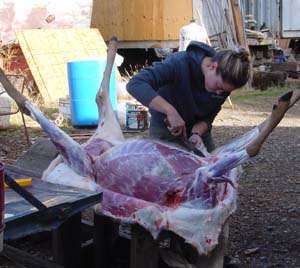
While we are not avid hunters, and we do not go out into the woods to harvest wild animals, animals still come into our main living area and help themselves to the fruits of our labor. Windward has proven time and again to be an irresistible target for animals to fill their bellies. We experience regular occurrences of predation from a host of animals. Whether it is skunks eating baby chicks, owls taking ducks in the night, deer vegging out on our orchards or alfalfa, or squirrels lifting eggs from under the laying hens, there is an ongoing dynamic between Windward and the wildlife that surrounds us.
One example of how native animals fit into our daily lives is our relationship to small mammals (smammals for short). During the spring and summer months the eggs and chicken feed is a tempting treat for smammals coming out of hibernation. We have a regular rotation of live-traps set up in our chicken coups to trap ground squirrels and skunks sneaking in for a snack.
The squirrels and skunks are occasionally skinned and cooked up fresh for lunch, but most of the time they are fed to insects which transform them into nutrient dense chicken food. We are also improving our skill and capacity to process the animal furs to use in various ways such as bags and coat linings.
We understand that resiliency in the face of constant change is founded on meeting your needs from a diverse array of sources, and as such we recognize wild animals as an important component of our path to sustainability.
In Summation
At Windward you’ll enjoy a remarkable opportunity to see these inter-meshing animals and humans in action, and come to understand the role that they play in our lives.
You’ll see how a variety of animals are helping us to feed, clothe, house and fuel our burgeoning village. You will also participate in some of the non-intuitive pieces of raising animals like building shelters to house them, fencing and seeding pasture to feed them, and partaking in the process of killing and processing their bodies.
It’s stewardship at its most down-to-earth, and Windward wouldn’t be what it is without them.
If you are interested in joining us for a season, or maybe longer, learn how to Get Involved
